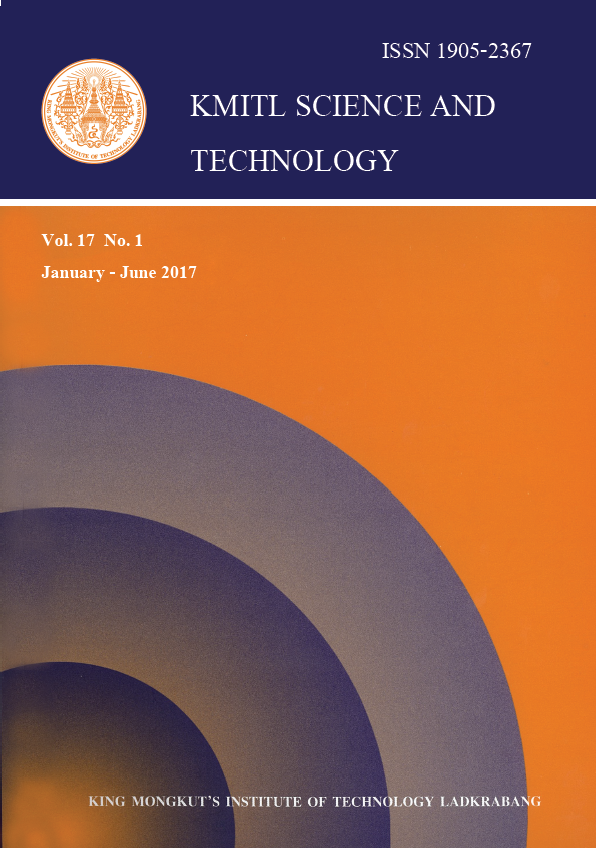The Dynamical Model of Dengue Vertical Transmission
Main Article Content
Abstract
Dengue disease is usually found in many parts of the world, including Africa, Asia, South America and Australia. Dengue disease can pass from one individual to another by two distinct mechanisms such as horizontal transmission and vertical transmission. In horizontal transmission, susceptible individuals can be infected by direct or indirect contacts with infectious individuals who are stays at the same time. Vertical transmission means to direct transmission from infected parents to their offspring before or during birth. In this study, the dynamical model of dengue disease was formulated by considering the vertical transmission in Aedes mosquitoes. The analysis of our model was given. The results of this study should introduce the alternative ways to reduce the dengue outbreak.
Keywords: Aedes mosquitoes, dengue, dynamical model, vertical transmission
*Corresponding author: Tel.: (662) 329-8400-11 Fax: (662) 329-8412
E-mail: kppuntan@kmitl.ac.th
Article Details
Copyright Transfer Statement
The copyright of this article is transferred to Current Applied Science and Technology journal with effect if and when the article is accepted for publication. The copyright transfer covers the exclusive right to reproduce and distribute the article, including reprints, translations, photographic reproductions, electronic form (offline, online) or any other reproductions of similar nature.
The author warrants that this contribution is original and that he/she has full power to make this grant. The author signs for and accepts responsibility for releasing this material on behalf of any and all co-authors.
Here is the link for download: Copyright transfer form.pdf
References
[2] World Health Organization, 2016. Dengue control. [online] Available at: https:// www.who.int/denguecontrol/mosquito/en/.
[3] World Health Organization, 1997. Dengue Hemorrhagic fever: Diagnosis treatment and control, Geneva.
[4] World Health Organization, 1997. Prevention and Control of Dengue and Dengue HaemorrhagicFever: Comprehensive Guidelines, WHO Regional Publication, SEARO, No.29.
[5] Lequime, S. and Lambrechts, L., 2014. Vertical transmission of arboviruses in mosquitoes: A historical perspective Infection. Genetics and Evolution, 28, 681-690.
[6] Carnegie Mellon University, 2010. Network Optimization. [online] Available at: https:// mat.gsia.cmu.edu/classes/QUANT/NOTES/chap11.pdf.
[7] Johnson, S., 1995. A Simulation model of the epidemiology of urban dengue fever: literature analysis, model development, preliminary validation, and samples of simulation results. American Society of Tropical Medicine and Hygiene, 53, 489-506.
[8] Moore, R., 1997. Mathematics in Biology and Medicine. [online] Available at: https:// www.maths.mq.edu.au/texdev/MathSymp/McElwain/node2.html.
[9] Esteva, L. and Vargas, C., 1999. A model for dengue disease with variable human population. Journal of Mathematical Biology, 38, 220-240.
[10] Syafruddin, S., Noorani, M.S.M., 2012. SEIR model for transmission of dengue fever in Selangor Malaysia. International Journal of Modern Physics: Conference Series, 9, 380–389.
[11] Sungchasit, R., Pongsumpun, P. and Tang, I.M., 2017. Environmental Impact on the Spread of Dengue Virus When Two Mosquito Species Circulate. Far East Journal of Mathematical Sciences, 101(1), 137-170.
[12] Pongsumpun, P., 2016. Dynamical model of dengue transmission in Aedesalbopictus and Aedesaegypti vectors with raining. Academic Journal of Science, 5(1), 345-352.
[13] Sungchasit, R., Pongsumpun, P. and Tang, I.M., 2015. SIR Transmission model of dengue virus taking into account two species of mosquitoes and an age structure in the human population. American journal of Applied sciences, 12 (6), 426-444.
[14] Murillo, D., Susan, A., Anarina, L., Murillo, F.S. and Carlos, C., 2014. Vertical Transmission in a Two-Strain Model of Dengue Fever. Letters in Biomathematics, 1(2), 249-271.
[15] Keshet, E.L., 1989. Mathematical models in biology. 1st ed. New York: Random House.
[16] Average Life Span Expectancy Chart, 2015. [online] Available at: https://www.disabled-world.com/calculators-charts/life-expectancy-statistics.php


